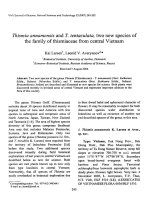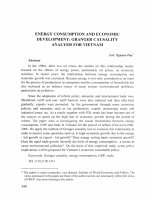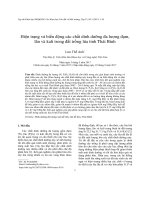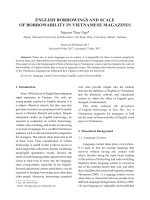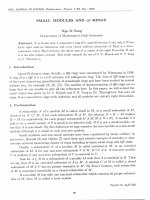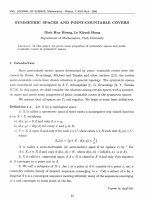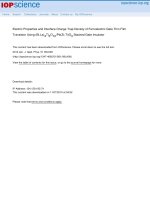DSpace at VNU: Ethnobotany ethnopharmacology and mass bioprospecting: Issues on intellectual property and benefit-sharing
Bạn đang xem bản rút gọn của tài liệu. Xem và tải ngay bản đầy đủ của tài liệu tại đây (116.38 KB, 8 trang )
Journal of Ethnopharmacology 100 (2005) 15–22
Perspective paper
Ethnobotany/ethnopharmacology and mass bioprospecting: Issues on
intellectual property and benefit-sharing
D.D. Soejarto a,b,∗ , H.H.S. Fong a , G.T. Tan a , H.J. Zhang a , C.Y. Ma a , S.G. Franzblau a ,
C. Gyllenhaal a , M.C. Riley a , M.R. Kadushin a,b , J.M. Pezzuto c , L.T. Xuan d , N.T. Hiep d ,
N.V. Hung d , B.M. Vu d , P.K. Loc d , L.X. Dac d , L.T. Binh d , N.Q. Chien d , N.V. Hai d ,
T.Q. Bich e , N.M. Cuong e , B. Southavong f , K. Sydara f , S. Bouamanivong f , H.M. Ly g ,
Tran Van Thuy h , W.C. Rose i , G.R. Dietzman j
a
PCRPS, College of Pharmacy, University of Illinois at Chicago, 833 S. Wood Street, Chicago, IL 60612, USA
b Field Museum, Chicago, IL, USA
c Schools of Pharmacy, Nursing, and Health Sciences, Purdue University, West Lafayette, IN, USA
d Vietnamese Academy of Science and Technology, Hanoi, Vietnam
e Cuc Phuong National Park, Ninh Binh, Vietnam
f Traditional Medicine Research Center, Vientiane, Laos
g Laboratory of Mycobacteria, National Institute of Hygiene and Epidemiology, Hanoi, Vietnam
h Department of Botany, Hanoi University of Science, Hanoi, Vietnam
i Bristol-Myers Squibb Pharmaceutical Research Institute, Princeton, NJ, USA
j White Point Systems, Friday Harbor, WA, USA
Accepted 23 May 2005
Available online 1 July 2005
Abstract
Ethnobotany/ethnopharmacology has contributed to the discovery of many important plant-derived drugs. Field explorations to seek and
document indigenous/traditional medical knowledge (IMK/TMK), and/or the biodiversity with which the IMK/TMK is attached, and its
conversion into a commercialized product is known as bioprospecting or biodiversity prospecting. When performed in a large-scale operation,
the effort is referred to as mass bioprospecting. Experiences from the mass bioprospecting efforts undertaken by the United States National
Cancer Institute, the National Cooperative Drug Discovery Groups (NCDDG) and the International Cooperative Biodiversity Groups (ICBG)
programs demonstrate that mass bioprospecting is a complex process, involving expertise from diverse areas of human endeavors, but central
to it is the Memorandum of Agreement (MOA) that recognizes issues on genetic access, prior informed consent, intellectual property and the
sharing of benefits that may arise as a result of the effort. Future mass bioprospecting endeavors must take heed of the lessons learned from
past and present experiences in the planning for a successful mass bioprospecting venture.
© 2005 Elsevier Ireland Ltd. All rights reserved.
Keywords: Ethnobotany; Ethnopharmacology; Mass bioprospecting; NCI; NCDDG; UIC ICBG; Intellectual property; Prior informed consent; Indigenous and
traditional knowledge; Benefit-sharing
1. Introduction
∗
Corresponding author. Tel.: +1 312 996 8889; fax: +1 312 413 5894.
E-mail address: (D.D. Soejarto).
0378-8741/$ – see front matter © 2005 Elsevier Ireland Ltd. All rights reserved.
doi:10.1016/j.jep.2005.05.031
The definition of the term ethnobotany, originally applied
to the study of the utilitarian relationship [relationship that
includes use for medicinal purposes] between humans and the
plant environment in primitive settings (Harshberger, 1896),
16
D.D. Soejarto et al. / Journal of Ethnopharmacology 100 (2005) 15–22
has now evolved into a much broader meaning that covers
not only a utilitarian relationship, but also relationships that
embrace the symbolic, ecological and cognitive, as well as
the human–plant relationship in a modern setting (Schultes
and von Reis, 1995; Alexiades, 1996). On the other hand, the
more recent term ethnopharmacology has undergone only
slight evolution in meaning since its original definition as “a
multi-disciplinary area of research, concerned with the observation, description and experimental investigation of indigenous drugs and their biological activities” (Rivier and Bruhn,
1979). Its contemporary definition addresses the “interdisciplinary study of the physiological actions of plant, animal
and other substances used in indigenous medicines of past
and present cultures” (International Society of Ethnopharmacology Constitution, 2005). The breath of studies embraces
“use of plants, fungi, animals, microorganisms and minerals and their biological and pharmacological effects based on
the principles established through international convention”,
as well as “the observation and experimental investigation
of the biological activities of plant and animal substances”,
using ethnopharmacological, ethnobotanical, ethnochemical,
pharmacological and toxicological approaches (Journal of
Ethnopharmacology, 2005).
Since these two branches of scientific disciplines carry a
common denominator, namely the human or cultural component inherent in the word “ethno”, ethnobotanical and
ethnopharmacological studies normally involve field explorations of indigenous as well as traditional medical knowledge (IMK/TMK), together with the biodiversity component
to which such knowledge is attached, documentation and conversion of the knowledge into a product, be it a scholarly
paper, a book, photographic images or a tangible product of
commercial value. In this process, when the purpose and outcome are commercial in nature, the activity is known today
as “bioprospecting”, a concept originally introduced in 1989
for “chemical prospecting” (Eisner, 1989, 1992) and was redefined in 1993 as “biodiversity prospecting” (Reid et al.,
1993). The term applies also to the exploration and utilization of the biological diversity itself for commercial purposes,
either within the context of IMK/TMK or without.
Twenty-five years ago, when the Journal of Ethnopharmacology was established (Journal of Ethnopharmacology 1
(1) 1979), bioprospecting was considered natural and justified, because the outcome benefits the scientific and general
communities, locally and globally. In fact, bioprospecting
has been going on for centuries, but only within the past 20
years has this activity gained prominence due to technological
advances in pharmaceutical, biotechnological and agricultural sectors. Before this period, little thought was given to the
issue of ownership of IMK and TMK and of the distribution
of benefits that may arise as the result of the bioprospecting
effort. This had been due, in part, to the general attitude at
that time that the world’s biodiversity, namely the genetic or
biological resources with which IMK/TMK is attached, represents a common heritage of man (FAO, 1983) and so does
the IMK/TMK.
2. Recognition of IMK/TMK and “sovereign rights”
over genetic resources
The turning point on the formal recognition of ownership of indigenous and traditional knowledge took place
in 1988 at the first International Congress of Ethnobiology
(ICE) in Bel´em (Brazil), with the “Declaration of Bel´em”
( which is
embodied within the Code of Ethics of the International
Society of Ethnobiology (2005) (.
edu/ISE/iseEthics.html). The Code of Ethics states that
“indigenous peoples, traditional societies and local communities have a right to self determination (or local determination for traditional and local communities) and that
researchers and associated organizations will acknowledge
and respect such rights” (Principle 2) and that they “must
be fairly and adequately compensated for their contribution
to ethnobiological research activities and outcomes involving
their knowledge” (Principle 12). In the context of IMK/TMK,
IMK/TMK represents the property of the holders of that
knowledge and must be respected, and that compensation
to the holders must be provided for the utilization and conversion of such knowledge (bioprospecting) into a tangible
product. In the second ICE in 1991, in Kunming, PRC, participants went further to declare that traditional and indigenous
knowledge are inventive and intellectual, therefore, worthy
of protection in all legal, ethical and professional frameworks
(International Society of Ethnobiology Constitution, 2005).
In 1992, the recognition of ownership of traditional knowledge and the biodiversity to which the knowledge is attached,
and the sharing of the benefits that may arise as a result of their
utilization was enforced in the form of the United Nations
Convention on Biodiversity (Secretariat of the Convention
on Biological Diversity, 2001, Articles 15.1 and 8.j).
The Bel´em Declaration, the Kunming Action Plan, the
United Nations Convention on Biodiversity and numerous
other Declarations of similar nature represent the instruments
for States to legislate the utilization and protection of their
natural resources that include the biological diversity. One of
the earlier biodiversity policy regulations enacted by a country was the Executive Order 247 (EO 47) (1995) introduced
by the President of the Republic of the Philippines. Other
countries have also enacted legislation or are in the process
of regulating their policy. Numerous national and international forums have been convened toward the legislation of
a national bioprospecting policy. Central to any policy on
bioprospecting are the issues on intellectual property, as it
pertains to IMK/TMK, and the benefit-sharing of the process
and the outcome that may arise from the activity.
Bioprospecting is performed by a diverse class of people,
non-scientists and scientists alike. Although the context of
this paper is ethnobotany and ethnopharmacology, the discussion that follows covers bioprospecting activities triggered
by the search and utilization of IMK/TMK, as well as by the
search and utilization of the component to which IMK/TMK
is attached. When the activity of bioprospecting involves a
D.D. Soejarto et al. / Journal of Ethnopharmacology 100 (2005) 15–22
large-scale effort to search and commercialize IMK/TMK
and/or the biological diversity, this effort is referred to as
“mass bioprospecting”.
3. Mass bioprospecting: contemporary models
The effort of the United States National Cancer Institute
(NCI) in searching for anticancer agents from the biodiversity, in the present context, of plants, is one example of
mass bioprospecting. In this effort, field explorations are
largely guided by the so-called biodiversity or “random”
collection approach, with ethnobotanical or ethnopharmacological information playing a minimal or no role. NCI
launched its effort in 1955, and for the period of 1960–1982,
about 114,000 extracts from an estimated 35,000 plant samples (representing 12,000–13,000 species) collected mostly
from temperate regions of the world had been screened
against a number of tumor systems (Cragg and Boyd, 1996;
Cragg et al., 1996). A wide variety of compound classes
were isolated and characterized. Clinically significant cancer chemotherapeutic agents that emerged from this program included paclitaxel (Taxus brevifolia Nutt. and other
Taxus species, Taxaceae), hycamptamine (topotecan), CPT11 and 9-aminocamptothecin. The latter three compounds
are semisynthetic derivatives of camptothecin (Camptotheca
acuminata Decne., Nyssaceae) (Cragg et al., 1993). The program was extended from 1986 to 2004, with an emphasis
on global plant collections and screening against tumor cell
cultures. Although no provision was made in the recognition of intellectual property and and in the arrangement of
benefit-sharing during the first phase of the NCI’s effort
(1955–1980), a “Letter of Intent”, later evolving into a “Letter of Collection” (LOC), then a Memorandum of Agreement
(MOA), was in place as an umbrella for the field operation of the NCI contractors in the second phase of NCIsponsored explorations (1986–2004). The LOI/LOC/MOA
contains provisions to recognize the ownership of genetic
resources and an arrangement to share the benefits of
discovery (Mays and Mazan, 1996; Hallock and Cragg,
2003).
In 1983, the NCI’s mass bioprospecting effort was
extended through the establishment of a National Cooperative Drug Discovery Group (NCDDG) program by the
Developmental Therapeutics Program (DTP), Division of
Cancer Treatment and Diagnosis (DCT). This program supports broad, innovative and multi-disciplinary approaches
to the discovery of new, synthetic or natural-source-derived
anticancer agents (Hallock and Cragg, 2003; NCI-DTPDCTGCOB, 2005). In the programs that target biodiversity as the source of discovery, biodiversity-based collection
approach also formed the basis of organism selection. In the
NCDDG program, issues on IP and benefit-sharing were dealt
with individually by each group. Recently, the overall effort
and accomplishments of the NCDDG projects were reviewed
(Hallock and Cragg, 2003).
17
Commencing in 1993, the International Cooperative Biodiversity Groups (ICBG), a program administered by the Fogarty International Center (FIC), National Institutes of Health
(NIH) and supported through funds from NIH, National Science Foundation (NSF) and US Department of Agriculture
(USDA) Foreign Agricultural Service (FAS), started operation in an effort to integrate the goals of improvement of
human health through drug discovery, incentives for conservation of biodiversity and development of new models
of sustainable economic activity that focus on the environment, health, equity and democracy. The implementation
of this program is based on the belief that the discovery
and development of pharmaceutical and other useful agents
from the world’s biodiversity can, under appropriate circumstances, promote scientific capacity development and economic incentives to conserve the biological resources from
which these products are derived (Fogarty International Center, 2004). This unique effort is undertaken in such a way that
local communities and other source country organizations
can derive direct benefits from the effort and, ultimately, from
their diverse biological resources, so that benefit-sharing may
provide clear incentives for preservation and sustainable use
of the biodiversity (Rosenthal, 1996, 1997; Rosenthal et al.,
1999; Fogarty International Center, 2004).
The ICBGs’ drug discovery effort is targeted to a broad
range of organisms, including five of the six recognized kingdoms of biodiversity: Eubacteria, Protoctista, Plantae, Fungi
and Animalia (NIH News, 2003).
4. “Studies on biodiversity of Vietnam and Laos”: an
ICBG program based at the University of Illinois at
Chicago
A complete review of the ICBGs has been published
(Rosenthal and Pezzuto, 1999). The University of Illinois at
Chicago (UIC)-based ICBG, known simply as “UIC ICBG”
or “Studies on Biodiversity of Vietnam and Laos” (Soejarto et
al., 1999, 2002a,b, 2004a,b), serves as a model for the implementation of the ICBG principles, which are, ultimately, the
principles of the United Nations Convention on Biological
Diversity. In its current Phase II operation (2003–2008), this
ICBG consortium consists of two US-based academic institutions (UIC and Purdue University), two Vietnamese research
institutions (Vietnamese Academy of Science and Technology; and Cuc Phuong National Park), one Lao research
institution (Traditional Medicine Research Center) and an
industrial partner (Bristol-Myers Squibb, BMS). Although
the drug discovery and development objective of the UICICBG is to uncover biologically active molecules from plants
of Vietnam and Laos as chemotherapeutic candidates for
malaria, tuberculosis, AIDS, cancer and CNS-related diseases, the bioprospecting goals are more all-encompassing,
namely: (a) to discover and develop new drugs from plants of
Vietnam and Laos (as just stated); (b) to promote economic
development among communities in the ICBG study areas
18
D.D. Soejarto et al. / Journal of Ethnopharmacology 100 (2005) 15–22
and to promote institutional-infrastructure strengthening and
human-resource development of host-country institutions; (c)
to undertake biotic survey and to promote conservation initiatives in Vietnam and Laos. In other words, the UIC ICBG
is a bioprospecting endeavor that is truly multi-disciplinary
and multi-national, and truly integrates drug discovery, biodiversity conservation and economic development. Since space
only allows a rather narrow discussion, addressing, specifically, the drug discovery and development activities, readers
are directed to papers already published that document activities in response to the other two goals of the UIC ICBG’s
bioprospecting effort (Hiep and Loc, 2000; Riley, 2001; Soejarto et al., 2001, 2002c,d, 2004a,b; Dietzman et al., 2002;
Hiep et al., 2002; Loc et al., 2002, 2004; Vu et al., 2002a,b;
Bien et al., 2003, 2004; Dzu et al., 2003; TMRC, 2003; Dac
et al., 2004; ICBG/AP4, 2005).
In drug discovery and development, approaches utilized
in the selection of plants consist of biodiversity-based collection [“random” collection] centered in the Cuc Phuong
National Park in Vietnam, and ethnobotany-driven interviews
on the medicinal uses of plants in Laos. Ethnobotanical interviews were also performed in Vietnam during the first Phase
of the UIC ICBG project (1998–2003), among communities
(Muong ethnic minority) in villages surrounding CPNP.
Seven years after the start of the UIC ICBG project
(1998–2005), 3331 plant samples have been collected from
Vietnam (Cuc Phuong National Park/CPNP) based on biodiversity (“random”) approach, comprising >950 species of
flowering plants identified to species level. Since the results
of the taxonomic inventory of plants in this park indicate
that 1926 species of Angiosperms (Soejarto et al., 2004c)
are found at CPNP, >900 species still remain to be collected and screened. In addition, 960 plant samples (about
>700 species) have been collected based on ethnobotanical/ethnopharmacological field interviews with Muong communities surrounding CPNP in Vietnam, and with ethnic
communities throughout Laos. For every plant sample collected, a set of seven voucher herbarium specimens was
collected for deposit at the consortium’s herbaria and at other
herbaria of collaborating botanical institutions.
The drug discovery process in the UIC ICBG follows
classic pharmacognosy methods, through sample extraction, high-throughput screening of extracts in the target disease system, recollection of samples (same plant parts) of
active species and bioassay-guided fractionation and isolation. CH2 Cl2 -soluble extracts or CHCl3 - or CH2 Cl2 -soluble
fractions from MeOH/EtOH extracts are assayed, after elimination of tannins and polyphenols, which are known to
interfere with certain enzyme-based assays.
Extracts that have shown confirmed activity are
fractionated/isolated using an effective combination of expertise and advanced separation technology protocol, typically based on the combination of flash (Isco CombiFlash
SG100C Separation System), semi-preparative and preparative HPLC chromatography, while droplet counter-current
systems are employed to maximize efficiency. Traditional
methods include vacuum, gravity, flash or low–medium pressure column chromatography using a variety of adsorbents
and media. Early LC/MS/MS-based dereplication strategies
that favor novel bioactive molecules over non-specific, known
and/or unwanted compounds from mixtures are employed to
support the bioassay-directed fractionation and isolation process. Chemical profiling by HPLC–MS is used, especially, for
chemotaxonomically related species under investigation.
State-of-the-art physical and spectroscopic methods, such
as high field nuclear magnetic resonance spectrometry
(NMR), time-of-flight mass spectrometry (TOF-MS), chemical ionization (CI), field desorption and fast-atom bombardment (FAB) MS, are employed in structure elucidation of
active compounds. Stereochemistry is determined by the use
of ORD and CD, coupled with high-field 1 H and 13 C NMR
spectroscopy, with appropriate two-dimensional (2D) and
decoupling experiments. The use of single crystal X-ray crystallographic analysis is routinely performed to solve difficult
stereochemistry assignments.
At the end, new compounds that are routinely isolated
based on a particular biological activity are included in the
UIC ICBG natural products library and incoporated in the
NAPIS Database, the computerized documentation system
utilized in the ICBG program, for periodic submission to
the ICBG’s Global Data Center (GDC) based in Friday Harbor, Washington State. These compounds may eventually be
exposed to multiple screens across the ICBGs.
5. UIC ICBG bioprospecting effort: results
Of the 3331 samples collected, extracts of 2309 (comprising approximately 800 species) have been screened in
anti-HIV, antimalaria and anti-TB disease systems, as well
as in a tumor cell lines panel. Twenty-two recollections of
active samples have been made and approximately 280 pure
natural products of varying degrees of structural complexity and/or biological activity have been isolated. Aside from
the discovery of biologically active compounds, the UIC
ICBG studies have also made significant contribution to the
knowledge of natural products chemistry through the isolation and elucidation of 80 new secondary metabolites and
novel chemical entities, reported for the first time from higher
plants. This high number may have been the result of rigorous prioritization criteria in the project, based on pre-existing
biological and chemical information (both at species and
generic levels), as well as on a chemical dereplication strategy using the resources and expertise available at UIC. The
chemical diversity of these new natural products includes
alkaloids/amides, macrocyclics, lignans, neolignans, butenolides, phenylpropanoids, terpenes, norditerpenes, triterpenes
and steroids (Zhang et al., 2001, 2002a,b; Chien et al., 2004).
Ten of the 80 new chemical entities have a novel carbon skeleton, being described and communicated for the first
time, all of which are structurally related anti-HIV sesquiterpenes (litseaverticillols A–J) isolated from Litsea verticillata
D.D. Soejarto et al. / Journal of Ethnopharmacology 100 (2005) 15–22
Hance (Lauraceae). These compounds are unique, because
they are ␣,-conjugated pentacyclosesquiterpenes with a
nine-member side chain (Zhang et al., 2003, in press). A
number of the active anticancer compounds are in various
stages of preclinical testing, including evaluation in animal
models.
Central to the existence and operation of the UIC ICBG is
the Memorandum of Agreements (1999–2005, 2004–2010),
which spell out issues on access to genetic resources and to
IMK/TMK, recognition of intellectual property rights on discovery and on IMK/TMK, and the sharing of benefits as part
of the bioprospecting process, as well as of the benefits that
may materialize (long-term benefits, namely royalties), as a
result of the bioprospecting effort (Soejarto et al., 2004a,b).
6. Mass bioprospecting in the future
Estimates place the number of species of organisms at between 1,392,485 (Wilson, 1988) and 1,750,000
(Hammond, 1995), classified into Kingdoms Eubacteria (bacteria, cyanobacteria “blue-green algae”), Archaea
(halobacterians, methanogens, eocytes), Protoctista (protozoa, “algae”), Plantae (land plants), Fungi (molds, lichenforming, yeasts, mushrooms) and Animalia (mesozoa, invertebrates, mammals) (Hammond, 1995).
Examination of the statistics on number of described
species shows that arthropods (Kingdom Animalia), comprising about 1,085,000 species, including insects, make
up the largest portion (75.4%) of the earth’s biodiversity (Hammond, 1995). Insects alone, estimated at 950,00
species, comprise 62% of global biodiversity. Despite the fact
that the number of insect species is estimated to be between
2,000,000 and 100,000,000 (Hammond, 1995), this group
remains relatively untouched as a source of novel compounds
by the drug discovery community. Animal species [Kingdom
Animalia], excluding the arthropods, comprise 13%, while
the fungi and the protists [protoctists] represent 4% and 5%
of global biodiversity, respectively. It is reasonable to assume
that the overwhelming majority of fungal species have yet to
be isolated and tested for the production of biologically active
compounds, even though members of the order Actinomycetales, like Streptomycetes, have been the most prominently
known microbial producers of natural products.
Based on the number of known species (300,000–500,000)
(Hammond, 1995), plants represent the second largest source
of biodiversity (15%). Estimates have been made that
between 20,000 and 55,000 species of plants have been used
medicinally (Penso, 1976; Schippmann et al., 2002), of which
only a small portion has been investigated for drug purposes.
Among those that have been investigated are plant species
that produce important drugs such as quinine, reserpine,
tubocurarine, vincristine, vinblastine, pilocarpine, atropine,
morphine, coccaine, to mention a few. Overall, only 15–20%
of terrestrial plants have been evaluated for pharmaceutical potential. Consequently, plants, including univestigated
19
medicinal plants, continue to represent a significant pool of
raw material for the discovery of new drugs.
With the biodiversity statistics presented above, the
world’s biodiversity and the ethnobotanical and ethnopharmacological treasure house that remains in store will continue
to present an attractive target for future mass bioprospecting
effort.
7. Discussion and conclusions
From the experiences gained through the participation in
the NCI (Soejarto, 1993; Soejarto et al., 1996), NCDDG
(Kinghorn et al., 2003) and ICBG (Soejarto et al., 1999,
2002a,b, 2004a,b) bioprospecting projects described above,
clearly, such endeavors are a highly complex process. Future
mass bioprospecting effort must incorporate lessons learned
from these experiences. The most important consideration
is the broad spectrum of requirements that must be amalgamated: team scientific expertise (of all relevant disciplines)
together with expertise in a wide range of human endeavors,
including diplomacy, international laws and legal understandings, social sciences, politics, anthropology and good common sense. Equally important is the fact that such endeavors
must be international in nature, with the participation and
cooperation of partner institutions located in biodiversityrich countries. For drug-targeted bioprospecting, an industrial
partner is a necessity, which will move a discovery into the
pipeline toward commercial product.
Central in any mass bioprospecting is the drafting and
signing of an international agreement or Memorandum of
Understanding (MOU) or MOA, that should cover issues
on access to the genetic resources [the biodiversity], on IP
related to discovery, on the sharing of the benefits as part
of the process (short-term) and in the event of discovery
and commercialization of a product (long-term), as well
as on the conservation of the biological resources for the
future generations. When ethnobotanical or ethnopharmacological approach is utilized, additional specific requirements that relate to prior informed consent (PIC), recognition of Indigenous Intellectual Property (IIP) and Indigenous
Intellectual Property Rights (IIPR), as well as short- and
long-term benefit-sharing are “priority” items to take into
account.
Collection methodology that facilitates recollection, in the
event of active species, is essential in order to ensure a reliable supply of biomass for larger scale compound isolation
to meet the requirements of in vivo and late-stage preclinical studies. This includes good field documentation, use of
Global Positioning System (GPS) to pinpoint site locations,
mapping of sites and the ready availability of superior computer database support. As an example, the field data for the
UIC ICBG program are posted on the Internet in the “Atlas
of Seed Plants of Cuc Phuong National Park” (). This information is also made available
in hardcopy form (Soejarto et al., 2004c). Good collection
20
D.D. Soejarto et al. / Journal of Ethnopharmacology 100 (2005) 15–22
methodology is especially important for marine sites, though
collection technology is different (Wright et al., 1996). Needless to say, precise taxonomic identification of organisms
involved either in the field, or with subsequent support from
taxonomic specialists, is crucial for accurate recollection
of organisms or targeted collection of specific organisms
(Soejarto, 1996).
Another important tool is plant tissue or cell culture
technologies, which are suited for scale-up production of
bioactive metabolites once they have been determined to
be of interest (DiCosmo and Misawa, 1995; Kirakosyan et
al., 2004). In the UIC ICBG, plant cell culture has been
applied to eliminate the uncertainty of re-accessing native
plant samples that have exhibited interesting chemistry. Further development of sustainable supplies of compounds for
clinical trials or commercialized drugs is critical, and may
proceed by exploring sustainable harvest methods, cultivation (including aquaculture), microbial fermentation, genetic
engineering and semi-synthesis or synthesis of candidate
drugs or analogs (Wender et al., 1999). Such effort will
ensure adequate supply of the compound while protecting
the source organism and its habitat from overexploitation.
Planning for sustainability should begin early in product
development (Cragg et al., 1993; Cragg, 1998). In the UICbased Vietnam–Laos ICBG, plant tissue culture is also being
used to produce biomass of rare and threatened species
at Cuc Phuong National Park, for purposes of both biological evaluation and increasing species population in the
park. It is also intended to promote economic development
among communities in the ICBG research site by helping
members of the community to generate income from distributed starter plants, in cases of economically valuable
species.
Acknowledgements
The UIC ICBG bioprospecting project, “Studies on Biodiversity of Vietnam and Laos”, is supported by Grants 1UO1-TW01015-01 (1998–2003) and 2-UO1-TW001015-06
(2003–2008), International Cooperative Biodiversity Groups
Program, at the Fogarty International Center, National Institutes of Health (NIH), through funds from the NIH, National
Science Foundation (NSF) and Foreign Agriculture Service
of the United States Department of Agriculture (USDAAFS). The authors express thanks to government authorities
of Vietnam and Laos for their cooperation and for the access
provided to the biological resources of Vietnam and Laos,
respectively, for the ICBG study.
References
Alexiades, M.N. (Ed.), 1996. Selected Guidelines for Ethnobotanical
Research: A Field Manual. New York Botanical Garden, Bronx, NY,
306 pp., i-xx.
Bien, L.K., Hiep, N.T., Loc, P.K., Cuong, N.M., Soejarto, D.D., 2003.
The diversity of the flora of Vietnam 14. Symphorema Roxb. and S.
involucratum Roxb., a new genus and species occurrence for the flora
of Vietnam. Genetics and Applications 3, 34–38.
Bien, L.K., Hiep, N.T., Soejarto, D.D., Cuong, N.M., Loc, P.K., 2004.
The diversity of the flora of Vietnam 16. Some more data on Tubocapsicum (Wettst.) Makino and T. anomalum (Franch. et Savat.) Makino
(Solanaceae), little known genus and species of the flora. Genetics
and Applications 2, 28–32.
Chien, N.Q., Hung, N.V., Santarsiero, B.D., Mesecar, A.D., Cuong, N.M.,
Soejarto, D.D., Pezzuto, J.M., Fong, H.H., Tan, G.T., 2004. New 3-Oacyl betulinic acids from Strychnos vanprukii Craib. Journal of Natural
Products 67, 994–998.
Cragg, G.M., 1998. Paclitaxel (Taxol): a success story with valuable
lessons for natural product drug discovery and development. Medical Research Review 18, 315–331.
Cragg, G.M., Boyd, M., 1996. Drug discovery and development at the
National Cancer Institute: the role of natural products of plant origin.
In: Balick, M.J., Elisabetsky, E., Laird, S.A. (Eds.), Medicinal Plant
Resources of the Tropical Forest. Columbia University Press, New
York, pp. 101–136.
Cragg, G.M., Schepartz, S.A., Suffness, M., Grever, M.R., 1993. The
taxol supply crisis. New NCI policies for handling the large-scale
production of novel natural product anticancer and anti-HIV agents.
Journal of Natural Products 56, 1657–1668.
Cragg, G.M., Simon, J.E., Jato, J.G., Snader, K.M., 1996. Drug discovery
and development at the National Cancer Institute: potential for new
pharmaceutical crops. In: Janick, J. (Ed.), Progress in New Crops.
ASHS Press, Arlington, VA, pp. 554–560.
Dac, L.X., Hai, H.H., Ha, D.T.H., Danh, N.T., Xuan, L.T., Hai, N.V.,
Binh, L.T., 2004. Micropropagation and biodiversity conservation of
Litsea verticillata collected from Cuc Phuong National Park by using
plant tissue culture technique. Journal of Biotechnology 2, 479–486.
DiCosmo, F., Misawa, M., 1995. Plant cell and tissue culture: alternatives
for metabolite production. Biotechnology Advances 13, 425–453.
Dietzman, G., Khuong, D.V., Bich, T.Q., Cuong, N.M., Soejarto,
D.D., 2002. GIS (Geographic Information System)-based biodiversity assessment as a tool to support conservation initiatives at Cuc
Phuong National Park. Advances in Natural Sciences 3, 255–271.
Dzu, N.V., Hiep, N.T., Loc, P.K., Soejarto, D.D., 2003. Little known
species and new records on the occurrence of Angiosperm species
in Cuc Phuong National Park III. New records of Aroids (Araceae).
Advances in Natural Sciences 4, 1–14.
Eisner, T., 1989. Prospecting for nature’s chemical riches. Issues in Science and Technology 6, 31–34.
Eisner, T., 1992. Chemical prospecting: a proposal for action. In:
Borhmann, F.H., Kellert, S.R. (Eds.), Ecology, Economics, and Ethics:
The Broken Cycle. Yale University Press, New Haven, CT, pp.
196–202.
Executive Order 247, 1995. Prescribing Guidelines and Establishing a
Regulatory Framework for the Prospecting of Biological and Genetic
Resources, Their By-Products and Derivatives, for Scientific and
Commercial Purposes, and for Other Purposes. Executive Order No.
247, May 18, pp. 1–10 (available at files/
philippines-bioprospecting-1995-en.pdf).
FAO, 1983. Annex to Resolution 8/83. International Undertaking on
Plant Genetic Resources. In: Twenty-Second Session of the FAO
Conference, Rome (available at />Fogarty International Center, 2004. International Cooperative Biodiversity Groups (ICBG) (available at />icbg.html).
Hallock, Y.F., Cragg, G.M., 2003. National Cooperative Drug Discovery
Group (NCDDGs): a successful model for public private partnerships
in cancer drug discovery. Pharmaceutical Biology 41, 78–91.
Hammond, P.M., 1995. The record to date: described species. In: Heywood, V.H., Watson, R.T. (Eds.), Global Biodiversity Assessment.
D.D. Soejarto et al. / Journal of Ethnopharmacology 100 (2005) 15–22
Cambridge University Press, Cambridge, pp. 113–138 (Chapter
3.1).
Harshberger, J.W., 1896. The purposes of ethnobotany. Botanical Gazette
21, 146–154.
Hiep, N.T., Loc, P.K., 2000. The diversity of the flora of Vietnam. 4.
Gardneria Wall. and G. ovata Wall., a new genus and species for
the flora. Genetics and Applications 3, 10–13 (in Vietnamese with an
English summary).
Hiep, N.T., Soejarto, D.D., Loc, P.K., 2002. Tinh da dang cua he thuc vat
Viet Nam 10. Nyctocalos Teijsm. & Binn. Nuc nac leo (ho Nuc nac
Bignoniaceae), chi moi cho he thuc vat Viet Nam. Tap chi Di truyen
hoc va ung dung 1, 40–43 (The diversity of the flora of Vietnam 10.
Nyctocalos Teijsm. & Binn. (family Bignoniaceae), new genus for
flora of Vietnam. Genetics and Applications 1, 40–43).
ICBG/AP4, 2005. 50 Medicinal Plants Used by Muong People in Cuc
Phuong. Institute of Biotechnology. Associate Program 4, UIC ICBG,
Publ., Hanoi (in Vietnamese; postcard-size loose-bound booklet, fully
illustrated).
International Society of Ethnobiology Code of Ethics, 2005. Available at
/>International Society of Ethnobiology Constitution, 2005. Annex II (available at />International Society of Ethnopharmacology, 2005. ISE Constitution
(available at />Journal of Ethnopharmacology, 2005. Inside front cover. Journal of
Ethnopharmacology 98 (inside front cover).
Kinghorn, A.D., Farnsworth, N.R., Soejarto, D.D., Cordell, G.A., Swanson, S.M., Pezzuto, J.M., Wani, M.C., Wall, M.E., Oberlies, N.H.,
Kroll, D.J., Kramer, R.A., Rose, W.C., Vite, G.D., Fairchild, C.R.,
Peterson, R.W., Wild, R., 2003. Novel strategies for the discovery of
plant-derived anticancer agents. Pharmaceutical Biology 41, 53–67.
Kirakosyan, A., Sirvent, T.M., Gibson, D.M., Kaufman, P.B., 2004. The
production of hypericins and hyperforin by in vitro cultures of St.
John’s wort (Hypericum perforatum). Biotechnology and Applied Biochemistry 39, 71–81.
Loc, P.K., Do, N.T., Hoan, D.T., Hiep, N.T., Cuong, N.M., Soejarto,
D.D., 2002. Tinh da dang cua he thuc vat Viet Nam 12. Phrynium
hainanense T.L. Wu & S.J. Chen La dong che sau (ho Hoang tinh
Marantaceae), Loai bo sung cho he thuc vat Viet Nam. Tap chi Di
truyen hoc va ung dung 3, 23–26 (The diversity of the flora of Vietnam
12. Phrynium hainanense T.L. Wu & S.J. Chen (family Marantaceae),
new species for flora of Vietnam. Genetics and Applications 3, 23–26).
Loc, P.K., Hiep, N.T., Soejarto, D.D., Cuong, N.M., 2004. The diversity
of the flora of Vietnam 17. Anodendron howii Tsiang (Apocynaceae),
new species occurrence for the flora. Genetics and Applications 3,
36–39.
Mays, T.D., Mazan, K.D., 1996. Legal issues in sharing the benefits of
biodiversity prospecting. Journal of Ethnopharmacology 51, 93–109.
NCI-DTP-GCOB, 2005. NCI-DTP Website at />branches/gcob/gcob web3.html.
NIH News, 2003. Third Round Awards are Announced Under
Interagency Biodiversity Program (available at />news/pr/dec2003/fic-16.htm).
Penso, G., 1976. Inventory of Medicinal Plants and Compilation of a
List of The Most Widely Used Plants. Geneva, WHO Document
DPM/WP/78.2.
Reid, W.A., Laird, S.A., Gamez, R., Sittenfeld, A., Janzen, A.H., Gollin,
M.A., Juma, C., 1993. A new lease on life. In: Reid, W.A., Laird,
S.A., Meyer, C.A., Gamez, R., Sittenfeld, A., Janzen, D.H., Gollin,
M.A., Juma, C. (Eds.), Biodiversity Prospecting: Using Genetic
Resources for Sustainable Development. World Resources Institute,
pp. 1–52.
Riley, M.C., 2001. Traditional Medicine Research Center (TMRC): a
potential tool for protecting Traditional and Tribal Medicinal Knowledge in Laos. Cultural Survival Quarterly 24, 21–24.
Rivier, L., Bruhn, J.G., 1979. Editorial. Journal of Ethnopharmacology 1,
1.
21
Rosenthal, J.P., 1996. Equitable sharing of biodiversity benefits: agreements on genetic resources. In: Presentation at the International
Conference on Incentive Measures for the Conservation and the
Sustainable Use of Biological Diversity in Cairns, Australia, 25–28
March (The meeting was sponsored and organized by the Organisation for Economic Co-Operation and Development. The paper appears
in print form in the publication—Investing in Biological Diversity:
Proceedings of the Cairns Conference, OECD 1997, available at
/>Rosenthal, J.P., 1997. Integrating drug discovery, biodiversity conservation, and economic development: early lessons in the International
Cooperative Biodiversity Groups. In: Grifo, F., Rosenthal, J. (Eds.),
Biodiversity and Human Health. Island Press, Washington, DC, pp.
281–301.
Rosenthal, J.P., Pezzuto, J.M. (Eds.), 1999. Drug Discovery, Economic
Development and Conservation: The International Cooperative Biodiversity Groups. Swets & Zeitlinger, The Netherlands, pp. 1–144
(Pharmaceutical Biology 37, 1–144).
Rosenthal, J.P., Beck, D.A., Bhat, A., Biswas, J., Brady, L., Bridbord,
K., Collins, S., Cragg, G., Edwards, J., Fairfield, A., Gottlieb, M.,
Gschwind, L.A., Hallock, Y., Hawks, R., Hegyeli, R., Johnson, G.,
Keusch, G.T., Lyons, E.E., Miller, R., Rodman, J., Roskoski, J.,
Siegel-Causey, D., 1999. Combining high risk science with ambitious
social and economic goals. Pharmaceutical Biology 37, 6–21.
Schippmann, U., Leaman, D.J., Cunningham, A.B., 2002. Impact
of cultivation and gathering of medicinal plants on biodiversity:
global trends and issues. In: FAO, Biodiversity and The Ecosystem Approach in Agriculture, Forestry and Fisheries. Satellite Event
on the Occasion of the Ninth Regular Session of the Commission on Genetic Resources for Food and Agriculture. Rome, 12–13
October (Inter-Departmental Working Group on Biological Diversity for Food and Agriculture, Rome, available at />documents/show cdr.asp?url file=/docrep/005/aa010e/aa010e00.htm).
Schultes, R.E., von Reis, S. (Eds.), 1995. Ethnobotany: Evolution of a
Discipline. Chapman & Hall, London, 414 pp.
Secretariat of the Convention on Biological Diversity, 2001. Handbook of the Convention on Biological Diversity. Earthscan
Publications Ltd., London/Sterling, VA, pp. 3–26 (available at
/>Soejarto, D.D., 1993. Logistics and politics in plant drug discovery. The
other end of the spectrum. In: Kinghorn, A.D., Balandrin, M. (Eds.),
Human Medicinal Agents from Plants. American Chemical Society,
Washington, DC, pp. 98–111.
Soejarto, D.D., 1996. Biodiversity prospecting and benefit-sharing: perspectives from the field. Journal of Ethnopharmacology 51, 1–5.
Soejarto, D.D., Gyllenhaal, C., Ashton, P.S., Sohmer, S.H., 1996. Plant
explorations in Asia under the sponsorship of the National Cancer
Institute, 1986–1991: an overview. In: Balick, M.J., Elisabetsky, E.,
Laird, S.A. (Eds.), Medicinal Plant Resources of the Tropical Forest.
Columbia University Press, New York, pp. 284–310 (Chapter 21).
Soejarto, D.D., Gyllenhaal, C., Fong, H.H.S., Xuan, L.T., Hiep, N.T.,
Hung, N.V., Bich, T.Q., Southavong, S., Sydara, K., Pezzuto, J.M.,
2004b. The UIC ICBG (University Of Illinois at Chicago International Cooperative Biodiversity Group) Memorandum of Agreement:
a model of benefit-sharing arrangement in natural products drug
discovery and development. Journal of Natural Products 67, 294–
299.
Soejarto, D.D., Gyllenhaal, C., Regalado, J.C., Pezzuto, J.M., Fong,
H.H.S., Tan, G.T., Hiep, N.T., Xuan, L.T., Binh, D.Q., Hung, N.V.,
Bich, T.Q., Thin, N.N., Loc, P.K., Vu, B.M., Southavong, B.H.,
Sydara, K., Bouamanivong, S., O’Neill, M.J., Lewis, J., Xie, X.-M.,
Dietzman, G., 1999. Studies on biodiversity of Vietnam and Laos: the
UIC-based ICBG program. Pharmaceutical Biology 37, 100–113.
Soejarto, D.D., Gyllenhaal, C., Regalado, J.C., Pezzuto, J.M., Fong,
H.H.S., Tan, G.T., Hiep, N.T., Xuan, L.T., Hung, N.V., Bich, T.Q.,
Loc, P.K., Vu, B.M., Southavong, B.H., Sydara, K., Bouamanivong,
S., O’Neill, M.J., Dietzman, G., 2002a. An international collaborative
22
D.D. Soejarto et al. / Journal of Ethnopharmacology 100 (2005) 15–22
program to discover new drugs from tropical biodiversity of Vietnam
and Laos. Natural Product Science 8, 1–15.
Soejarto, D.D., Gyllenhaal, C., Tarzian Sorensen, J.A., Fong, H.H.S.,
Xuan, L.T., Binh, L.T., Hiep, N.T., Hung, N.V., Vu, B.M., Bich,
T.Q., Southavong, B.H., Sydara, K., Pezzuto, J.M., 2004a. Bioprospecting arrangement: experiences between the north and the
south. In: Mahoney, R. (Ed.), Handbook of Best Practices for Management of Intellectual Property in Health Research and Development. Centre for the Management of Intellectual Property in Health
Research and Development, MIHR, Oxford, UK, pp. 169–190 (third
printing).
Soejarto, D.D., Hiep, N.T., Loc, P.K., Bien, L.K., Dai, T.D., Regalado,
J.C., Cuong, N.M., 2002d. Little known species and new records on
the occurrence of angiosperm species in Cuc Phuong National Park. 1.
Heliciopsis lobata, Alangium tonkinense, Illigera parviflora, Keenania
tonkinensis, Lysimachia insignis, and Kadsura coccinea. Advances in
Natural Sciences 3, 57–70.
Soejarto, D.D., Hiep, N.T., Loc, P.K., Cuong, N.M., Bien, L.K., Dai, T.D.,
Kadushin, M.R., 2004c. Seed Plants of Cuc Phuong National Park,
Vietnam. A Documented Checklist. Cuc Phuong National Park, Ninh
Binh, Vietnam. Agricultural Publishing House, Hanoi, Vietnam, pp.
i–xxxiv, 1–760 (plates I–XCIX).
Soejarto, D.D., Regalado, J.C., Dietzman, G., Gyllenhaal, C., Hiep, N.T.,
Loc, P.K., Huong, N.T., Bich, T.Q., Cuong, N.M., 2001. Development and management of a computerized database of seed plants of
Cuc Phuong National park. In: International Workshop on Biology
(Workshop Proceedings), vol. 1, Hanoi (Vietnam), 2–5 July, pp. 192–
195.
Soejarto, D.D., Regalado, J.C., Hiep, N.T., Loc, P.K., Bien, L.K., Bich,
T.Q., Cuong, N.M., Kadushin, M.R., 2002c. Atlas of Seed Plants of
Cuc Phuong National Park (online, posted starting in 2002, available
at ).
Soejarto, D.D., Xuan, L.T., Vu, B.M., Dac, L.X., Bich, T.Q., Southavong,
B.H., Sydara, K., Bouamanivong, S., Zhang, H.J., Fong, H.H.S., Tan,
G., Pezzuto, J., Franzblau, S.G., Gyllenhaal, C., Riley, M.C., Hiep,
N.T., Loc, P.K., Hung, N.V., 2002b. Implementing IPR and benefitsharing arrangements: experiences in the University of Illinois at
Chicago–Vietnam–Laos ICBG. In: Intellectual Property Rights and
Traditional Knowledge on Genetic Resources in Pharmaceutical and
Cosmetic Business, JBA/NITE, International Symposium 2002, 14
November, Tokyo, Japan, pp. 47–83.
TMRC, 2003. Bulletin on Lao Traditional Medicine #5. Published by
Traditional Medicine Research Center, Ministry of Health, Vientiane,
Laos (in Lao language, Bulletin started in 2001).
Vu, B.M., Xuan, L.T., Hai, N.V., Soejarto, D.D., 2002a. ICBG Associate
Program 4 and Buffer Zones of Cuc Phuong National Park. Vietnam
Agriculture 87, 16 (in Vietnamese).
Vu, B.M., Xuan, L.T., Hai, N.V., Soejarto, D.D., 2002b. An ICBG/AP4created model of household economic development for a commune
in buffer zone of Cuc Phuong National Park. Journal of Economic
Development Review 59, 1–3 (in Vietnamese).
Wender, P.A., Hinkle, K.W., Koehler, M.F., Lippa, B., 1999. The rational
design of potential chemotherapeutic agents: synthesis of bryostatin
analogues. Medical Research Review 19, 388–407.
Wilson, E.O., 1988. The current state of biological diversity. In: Wilson, E.O., Peter, F.M. (Eds.), Biodiversity. National Academy Press,
Washington, DC, pp. 3–18.
Wright, A.D., Konig, G.M., Angerhofer, C.K., Greenidge, P., Linden,
A., 1996. Antimalarial activity: the search for marine-derived natural products with selective antimalarial activity. Journal of Natural
Products 59, 710–716.
Zhang, H.J., Hung, N.V., Cuong, N.M., Soejarto, D.D., Pezzuto, J.M.,
Fong, H.H.S., Tan, G.T. Natural anti-HIV constituents from Litsea
verticillata. Planta Medica, in press.
Zhang, H.-J., Qiu, S.-H., Tamez, P., Tan, G.T., Aygdomus, Z., Hung,
N.V., Cuong, N.M., Angerhofer, C., Soejarto, D.D., Pezzuto, J.M.,
Fong, H.H.S., 2002a. Antimalarial agents from plants II. Decursivine,
a new antimalarial indole alkaloid from Rhaphidophora decursiva.
Pharmaceutical Biology 40, 221–224.
Zhang, H.J., Tamez, P., Aydogmus, Z., Tan, G.T., Saikawa, Y., Hashimoto,
K., Nakata, M., Hung, N.V., Xuan, L.T., Cuong, N.M., Soejarto, D.D.,
Pezzuto, J.M., Fong, H.H.S., 2002b. Antimalarial agents from plants.
III. Trichothecenes from Ficus fistulosa and Rhaphidophora decursiva.
Planta Medica 68, 1088–1091.
Zhang, H.-J., Tamez, P.A., Hoang, V.D., Tan, G.T., Hung, N.V., Xuan,
L.T., Cuong, N.M., Thao, D.T., Soejarto, D.D., Fong, H.H.S., Pezzuto,
J.M., 2001. Antimalarial compounds from Rhaphidophora decursiva.
Journal of Natural Products 64, 772–777.
Zhang, H.-J., Tan, G.T., Hoang, V.D., Hung, N.V., Cuong, N.M., Soejarto,
D.D., Pezzuto, J.M., Fong, H.H.S., 2003. Natural anti-HIV agents. Part
III. Litseaverticillols A–H, novel sesquiterpenes from Litsea verticillata. Tetrahedron 59, 141–148.
